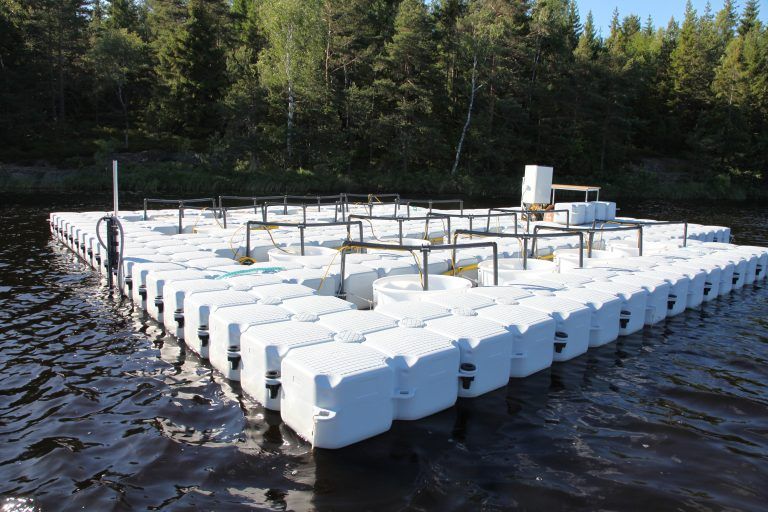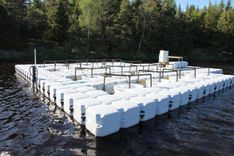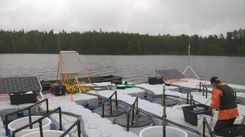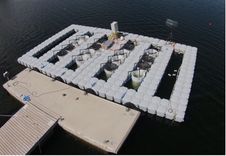Facilities
Transnational Access
Metadata & Data
Papers & Reports
Knowledge Base
SITES AquaNet
Uppsala University (UU)
Infrastructure Description
SITES AquaNet is a modular infrastructure with mesocosm facilities in lakes connected to 5 field stations (Asa, Bolmen, Erken, Skogaryd, Svartberget) that are part of the Swedish Infrastructure for Ecosystem Science (SITES). SITES AquaNet is coordinated by Uppsala University and the associated partners are the Swedish Agricultural University (SLU), Gothenburg University (GU) and Sweden Water Research (SWR). The unique feature of SITES AquaNet is that it is fully standardised across sites and therefore enables modularised experimental manipulations in lakes along a latitudinal gradient in Sweden. This includes a sensor and data logging system to measure in each mesocosm real-time environmental parameters, such as DO, temperature, photosynthetic active radiation, chlorophyll, phycocyanin and turbidity. The lakes in each respective station (Stortjärn, Erken, Erssjön, Feresjön and Bolmen) vary in local environmental conditions: https://www.fieldsites.se/en-GB/sites-thematic-programs/lakes-in-sites-44856978. This allows to achieve general conclusions on ecological phenomena; particularly how local differences between important variables across sites (e.g., temperature, elevation, nutrients and water colour) mediate the outcomes of experimental manipulations of explanatory predictors for the phenomena.
SITES AquaNet has established protocols to standardise both field and laboratory work. Each station is equipped with field equipment for collection of samples and there is access to cold storage, freezing rooms and laboratory facilities for filtering and extraction of samples for a wide range of analyses.
The Erken Laboratory can also provide 20 1500 L polyethylene enclosures.
Facility Description
- Outdoor, freshwater, deployed in an adaptable jetfloat, placed in the lake Erken close to the campus of the research station.
- 20 hardshell PE enclosures (ø = 0.9 m, depth =1.5 m, volume = 700 l). Possibility to use PE-film enclosures
- Sensor system for a minimum of 16 mesocosms: Agogee SQ-500 sensor for PAR, oxygen optode 4531 sensor (Aandeera) for dissolved oxygen and temperature, Trilux (Chelsea) for chlorophyll a fluorescence, turbidity and phycocyanin fluorescence

Organisation Address
Uppsala University
Box 256
Uppsala
SE-751 05
Sweden
(Linked third party)
Swedish Agricultural University (SLU Umeå)
Umeå
90183
Sweden
(Linked third party)
Gothenburg University (GU), Box 100
Gothenburg
405 30
Sweden
(Linked third party)
Sweden Water Research AB (SWR), Ideon Science Park
Lund
223 70
Sweden
Infrastructure Address
Erken Laboratory (UU)
Norra Malmavägen 45
Norrtälje
761 73
Sweden
Asa Research Station (SLU)
Lammhult
363 94
Sweden
Bolmen Research Station (SWR)
Tiraholm
Unnaryd
314 52
Sweden
Skogaryd Research Station (GU)
Universitetsplatsen 1
Sweden
Svartberget Research Station (SLU)
Svartberget Research Station
Vindeln
922 91
Sweden
Information Sources
Urrutia-Cordero, P., et al. (2021), SITES AquaNet: An open infrastructure for mesocosm experiments with high-frequency sensor monitoring across lakes. Limnol Oceanogr Methods.
https://www.fieldsites.se/en-GB/sites-thematic-programs/sites-aquanet-32634394
https://www.ieg.uu.se/erken-laboratory/ (Erken)
https://www.fieldsites.se/en-GB/research-stations/asa-32652326 (Asa)
https://forskningsstationbolmen.se/ (Bolmen)
https://www.gu.se/en/earth-sciences/skogaryd-research-catchment-0 (Skogaryd)
https://www.fieldsites.se/en-GB/research-stations/svartberget-32652421 (Svartberget)
Location
Gallery
Contacts
silke.langenheder@ebc.uu.se
Controlled Parameters
Possible manipulations include nutrient and substance additions, shading, food web manipulations, dispersal/species additions
Research Topics
Biodiversity-functioning-stability relationships, community ecology, ecological stoichiometry, food web interactions, benthic-pelagic dynamics, biogeochemistry (e.g., nutrient cycling), land-water-air gas exchange, cyanobacterial blooms and global change research.
Experiment Years
2017 - present
TA Support
Services currently offered by the infrastructure: External users have open access to equipment to run and participate mesocosm experiments in one or more lakes spread across a geographical and climatic gradient in Sweden. This includes sensor calibrations and installations, support with installing and uninstalling of mesocosms, online visualisation of sensor data, access to sensor data and lab space, equipment for sampling, and sample preparation and sampling protocols. Data from lake and time-series data is also available through SITES Water (coordinated by Skogaryd and Svartberget) comprising a multi-layered lake and stream monitoring program including hydrological, physical, chemical, and biological parameters as well as GHG and C fluxes. Additional technical and analytical support by experienced staff is available when costs are covered, including the possibility for water analyses in accredited laboratories. Activities at the different stations include a large variety of long-term monitoring programs and research projects within the field of ecosystem science, which gives users the possibility to interact with technical staff and researchers working at the stations.
Support offered under AQUACOSM-plus: TA users will have full access to the mesocosm infrastructure and services described above, as well as training by technical staff in sampling procedures and the use of equipment and instruments. Standard disposables, as well as administrative and logistic support (cars and boats), are also provided.
TA Modality of Access
Modality of access under AQUACOSM-plus: A total of 1600 person-days for the entire SITES AquaNet infrastructure will be allocated to external users supported by an AQUACOSM-plus TA activity. It is anticipated that AQUACOSM-plus will support a minimum of 5-7 persons for 50-60 days per year in M22-33 at each station. A typical experiment is expected to run for 6-8 weeks. The primary objective for access will be the implementation a coordinated experiment in all 5 lakes in SITES AquaNet that addresses a grand scientific challenge as defined in Work package 6. TA users will have the opportunity to be part of this synchronised experiment, which includes planning, on-site preparation, and implementation of experiments at the different field stations. The access costs are estimated based on real cost calculations.
TA Accommodation
Accommodation is either available at the stations or in nearby hostels.



